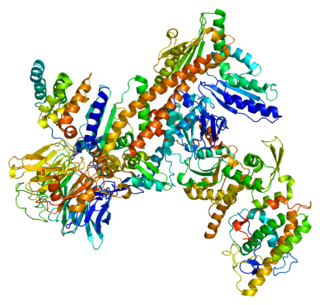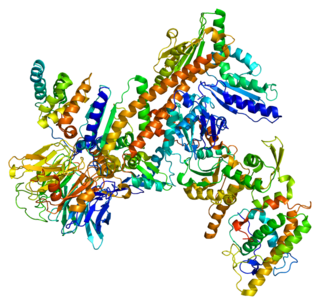
Actin beta is one of six different actin isoforms which have been identified in humans. This is one of the two nonmuscle cytoskeletal actins. Actins are highly conserved proteins that are involved in cell motility, structure and integrity. Alpha actins are a major constituent of the contractile apparatus.

Dynactin subunit 1 is a protein that in humans is encoded by the DCTN1 gene.

(See also: List of proteins in the human body)

(See also: List of proteins in the human body)

Dynactin is a 23 subunit protein complex that acts as a co-factor for the microtubule motor cytoplasmic dynein-1. It is built around a short filament of actin related protein-1 (Arp1).

Beta-adducin is a protein that in humans is encoded by the ADD2 gene.

Sodium/potassium-transporting ATPase subunit beta-1 is an enzyme that in humans is encoded by the ATP1B1 gene.

Alpha-centractin (yeast) or ARP1 is a protein that in humans is encoded by the ACTR1A gene.

Actin, gamma-enteric smooth muscle is a protein that in humans is encoded by the ACTG2 gene.

Actin-related protein 2/3 complex subunit 3 is a protein that in humans is encoded by the ARPC3 gene.

Cleavage stimulation factor 77 kDa subunit is a protein that in humans is encoded by the CSTF3 gene.

Bicaudal D cargo adaptor 2 is a protein that in humans is encoded by the BICD2 gene.

Neuronal acetylcholine receptor subunit alpha-5, also known as nAChRα5, is a protein that in humans is encoded by the CHRNA5 gene. The protein encoded by this gene is a subunit of certain nicotinic acetylcholine receptors (nAchR).

Spectrin beta chain, brain 2 is a protein that in humans is encoded by the SPTBN2 gene.

Actin-related protein 2/3 complex subunit 1A is a protein that in humans is encoded by the ARPC1A gene.

AP-4 complex subunit beta-1 is a protein that in humans is encoded by the AP4B1 gene.

Dynactin subunit 3 is a protein that in humans is encoded by the DCTN3 gene.

Troponin C, skeletal muscle is a protein that in humans is encoded by the TNNC2 gene.

AP-4 complex subunit mu-1 is a protein that in humans is encoded by the AP4M1 gene.

Actin-related protein 3B also known as ARP3-beta is a protein that in humans is encoded by the ACTR3B gene. Pseudogenes of this gene are located on chromosomes 2, 4, 10, 16, 22 and Y. Alternative splicing results in multiple transcript variants and protein isoforms.





















